




 |
   |
 |
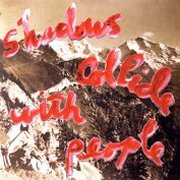 |
Shadows Collide With People (2003, 62.23) ***½/½ |
|
| Carvel Omission Regret Ricky Second Walk Every Person -00Ghost27 Wednesday's Song This Cold |
Failure33 Object Song to Sing When I'm Lonely Time Goes Back In Relief Water Cut-Out Chances 23 Go in to End The Slaughter |
|
Current availability:
Chamberlin used:
John Frusciante is best-known, of course, for being the on-off guitarist in the Red Hot Chili Peppers, although, drug problems seemingly overcome, he now seems like a fairly permanent fixture in the lineup. Shadows Collide With People is his fifth solo album, falling loosely into the same category as the current Chilis, although he allows himself more sonic variety, not least with the various strangely-named tracks here (-00Ghost27, Failure33 Object etc.), all experiments in noise and effects.
Frusciante plays Mellotron samples, along with almost everything else, it seems, his mate John Klinghoffer adding more sampled Mellotron, but REAL Chamberlin on closer The Slaughter, according to Frusciante's own site, with, er, a woodwind variation? Hard to say. Just for the record, those Mellotron samples crop up on no fewer than nine tracks, the most obvious use being Carvel's powerful strings opening section and flutes, filthy choirs on -00Ghost27 and a beautiful flute part on 23 Go In To End, although he also credits 'Mellotron horns' here and there.
See: Samples etc. | Red Hot Chili Peppers
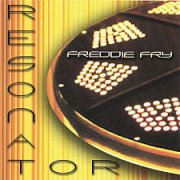 |
Resonator (2004, 46.53) ***/T |
|
| One of These Days Time Will Tell Doin' Time Who Could it Be? Angel in the House To Be Loved Ship of Fools This Time |
Take it Baby Darlin' Napali Daydream Live for Love |
|
Current availability:
Mellotron used:
Freddie Fry's Resonator is an album of two halves, both, admittedly, Americana-based. One half eschews maudlin pedal steels and the like, at its best on the bluesy Who Could It Be?, Ship Of Fools and closer Live For Love, but the other sinks into country clichés more often than is strictly necessary, not least Time Will Tell and This Time.
Fry appears to play real Mellotron on the album with a major flute part on Napali Daydream, complete with tape-slip and key-click. Good, but not great, one seemingly real Mellotron track. He also uses samples on 2010's Dream Tree EP.
See: Samples etc.
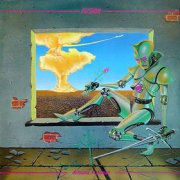 |
Fusion (1981, 39.17) ***/T |
|
| Fusion Jungle Forge Colombine Eclipse Discobole Arlequin Performance |
Milk-Shake Oxyde Week-End Telex |
|
Current availability:
Mellotron used:
Armand Frydman seems to chiefly be a soundtrack composer, although he's also recorded many 'stand-alone' albums, not least 1981's Fusion. Unsurprisingly, it contains both soundtrack and jazz-fusion elements, examples of the former including the opening title track, Forge and Week-End and of the latter, Jungle and Discobole. Mind you, the jaunty Arlequin and Milk-Shake fit into neither category, ditto synth-heavy highlights Oxyde and propulsive closer Telex.
Frydman plays Mellotron, amongst other keys (specifically, Yamaha electric grand, Clavinet, VCS3, Crumar organ and Maxi-Korg), with very background strings on the beautiful Colombine, string swells on Eclipse and more barely-Mellotronic strings on Discobole, making this one of the lesser Mellotron albums I've heard recently. Fusion isn't a bad album at all, although it's stylistically disparate enough that few listeners are likely to appreciate every track.
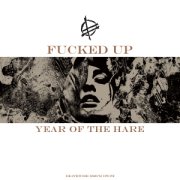 |
12" (2015) ***/T Year of the Hare California Cold |
Current availability:
Mellotrons used:
Toronto's supposed hardcore act Fucked Up are actually far more diverse than that sounds, particularly on 2015's Year Of The Hare b/w California Cold 12". It's effectively a mini-album, the 'A' being a startling twenty-one minutes long, moving through several sections (punk-prog?), slow and fast, piano- and guitar-driven, glued together in deliberately haphazard fashion, the eight-minute flip being more like an extended version of something from the previous year's long-player, Glass Boys.
Josh Zucker and Mike Haliechuk both get Mellotron credits; I have to say, while the string sounds on the 'A' are pretty murky, the severe wobble in any note held for more than three or four seconds is extremely authentic, to the point where I think I have to accept it as real.
See: Samples etc.
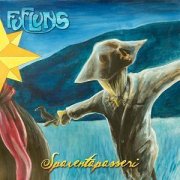 |
Spaventapasseri (2016, 59.52) ****/TTT½ |
|
| Grecale Lamento d'Uno Spaventapasseri Stella del Vespro Maestrale Tra 1000 Gendarmi l'Amore Ricordo di Nene Scirocco Come un Salice |
Morte di Nene Libeccio Il Foco Addio ai Corvi |
|
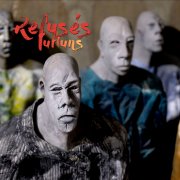 |
Refusés (2021, 61.54) ****/TT½Sierra LeoneMartirio d'un Falegname Canzone per Iris Desaparecido Italiano Il Tuffatore dello Stari Most Rosa del Deserto Blu Oltremare Telefonata a Putin Canto dei Bambini Senza Voce |
Current availability:
Mellotrons used:
Fufluns (named for the Etruscan god of plant life, fact fans) are an Italian prog supergroup, consisting of vocalist Simone Cecchini (Il Bacio della Medusa), bassist Guglielmo Mariotti (Taproban/The Watch), Keys man Alfio Costa (Tilion/Prowlers/Daal) and drummer Maurizio di Tollo (La Maschera di Cera), plus guests. Told you they were a supergroup. Their debut, 2016's Spaventapasseri, sits firmly in the grand Italian '70s tradition of song-based progressive rock, at its best on the lovely Maestrale, Tra 1000 Gendarmi L'Amore and closer Addio Ai Corvi. To be honest, the album starts off sounding not-so promising, but picks up as it progresses (ho ho), the material becoming more varied, ending up earning a solid four stars. Costa plays his M400 on around half the album, with rather low-in-the-mix strings and choirs on opener Grecale, more upfront strings on Lamento D'Uno Spaventapasseri, very wobbly strings on Tra 1000 Gendarmi L'Amore, a string line and distant choirs on Come Un Salice, a flute part on Morte Di Nene, chordal strings on Libeccio and flutes and more wobbly strings on Addio Ai Corvi.
It took the ensemble five years to follow up with Refusés, although the wait was worth it, the album being every bit as good as its predecessor. Highlights include Martirio D'Un Falegname, Canzone Per Iris and Blu Oltremare, but, despite (like their debut) being a little too long, there's absolutely nothing here that lets the RPI side down. In all seriousness, production aside, had I been told that this dated from 1975, I'd have been fooled. Yes, this is a good thing. Costa on Mellotron again, of course, used with more restraint than before (is this a good thing?). It's difficult to be certain, but the strings on opener Sierra Leone and closer Canto Dei Bambini Senza Voce sound less like his M400 and more like either samples or one of the more lifelike string synths. Is this is a composite sound? The jury remains out. Anyway, obvious Mellotron strings on Martirio D'Un Falegname, a flute line on Canzone Per Iris, beautiful chordal flutes on Desaparecido Italiano and Il Tuffatore Dello Stari Most, strings on Rosa Del Deserto and an ensemble flute part on Telefonata A Putin. Incidentally, the vinyl version chops two tracks, although they're available as downloads.
See: Alfio Costa
Führs & Fröhling (Germany) see: |
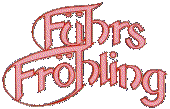 |
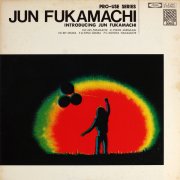 |
Introducing Jun Fukamachi (1975, 32.14) ***/TEvening StarNoah's Ark Perfidy Bamboo Bong La Fille Aux Chevaux de Lin |
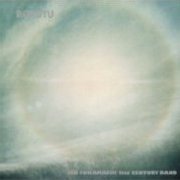 |
Rokuyu [as Jun Fukamachi 21st Century Band] (1975, 40.50) ***½/TMeikyūHateruma Shin-Kū Rokuyu |
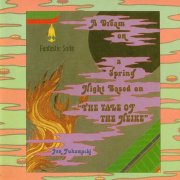 |
Fantastic Suite: A Dream on a Spring Night Based on "The Tale of the Heike" (1978, 40.23) ***½/TPrologueThe Bell of the Gion Temple The Prosperous Heike The Sinking Heike The Scenes of Bloodshedding The Heike Sent to the Sea Bottom The Specter of the Destructed Heike Epilogue |
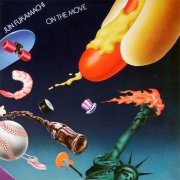 |
On the Move (1978, 46.00) **½/½On the MoveYou're Sorry Letter to N.Y. Departure in the Dark Dance of Paranoia Op.2 When I Got Your Wave "Pathetique" Early Evening Lullaby Departure in the Dark - Again |
Current availability:
Mellotrons used:
Jun Fukamachi (1946-2010) was a Japanese fusion musician of high repute, often spitting out two or more albums a year during his '70s solo career. The first one I know of after 1972's Hello! is '75's Introducing Jun Fukamachi, which pretty much does what it says on the tin. Unfortunately, the bulk of the album fits more into the 'funk/jazz' than 'rock/jazz' camp, although the Clavinet-driven Perfidy clips along nicely enough. The album's longest track, Bamboo Bong, is also the only one featuring Fukamachi's Mellotron, with a short (male?) choir part that doesn't really add that much to the album's appeal. The same year's Rokuyu (released as Jun Fukamachi 21st Century Band) starts off in a similar vein, getting rockier as it goes along, with fiery playing on Shin-Kū and an almost prog feel to some of the side-long title track. As with its predecessor, only one Mellotron track, with choirs on Rokuyu itself, though again, to no great effect. Fukamachi played Mellotron on Carmen Maki & Oz' first album the same year, although it's doubtful that he equalled even that limited use again.
I've only heard one of Fukamachi's interim albums, '77's Mellotron-free The Sea of Dirac (clearly referencing noted physicist Paul Dirac), making the following year's Fantastic Suite: A Dream on a Spring Night Based on "The Tale of the Heike", a concept piece based on an old Japanese folk legend, quite possibly his best album. It combines his beloved jazz with Japanese musical sensibilities, frequently resulting in sparse, near-atonal synth work, a long way from his usual comfort zone. That isn't to say that it's jazz-free, jazzier material including The Prosperous Heike and The Scenes Of Bloodshedding (principally in the piano department), but the album's default setting is closer to 'ambient piano and synth' than 'syncopated basslines'. Highlights include eerie opener Prologue, the experimental The Bell Of The Gion Temple, beautiful piano-and-synth piece The Heike Sent To The Sea Bottom and the brief, gloomy The Specter Of The Destructed Heike, although nothing here sounds too out of place. The Mellotron appears occasionally, with distant choirs on The Sinking Heike and The Specter Of The Destructed Heike, essentially a solo Mellotron choir piece, making it a shame he didn't use it a little more.
The credited Mellotron part on the following year's On the Move turns out to be a damp squib as, indeed, does most of the album. Fukamachi had slipped into a full-blown smooth jazz/fusion crossover by this point, apart from guitar-heavy closer Departure In The Dark - Again, just about the only listenable thing here. There's a little phased Mellotron choir on the earlier Departure In The Dark, but that seems to be your lot.
So; as I've commented elsewhere (possibly in my Passport reviews), jazz being America's one true, home-grown music, it tends to sound pretty much the same wherever and by whomever it's played, unlike, say, progressive rock, which proudly assimilates local musical characteristics. As a result, Japanese fusion sounds pretty much like German fusion sounds pretty much like American fusion, so is there anything to recommend Fukamachi over other, better-known artists? You'd have to ask a jazzer, I'm afraid; it's all enormously competent, but is that enough? Next to no Mellotron, either, so don't come here expecting to find another Release Music Orchestra.
See: Yōsui Inoue | Mayumi Itsuwa | Tokiko Kato | Carmen Maki & Oz | Hiroshi Miyagawa | Itsuroh Shimoda | Jiro Sugita
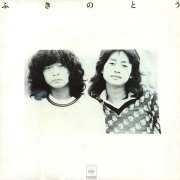 |
Fukinotou (1974, 39.48) **½/T |
|
| Kaerimichi Hitori Botchi de Amefuri Yūgure no Machi Natsu no Hito Purattohōmu Namida-iro no Machi Hitorigurashi |
Bai Bai Sūzan Hotaru Hanabi Roman Shiroi Fuyu |
|
Current availability:
Mellotron used:
Fukinotou were a folk duo from Hokkaido, in the far north of Japan, who released a clutch of albums between the early '70s and early '90s. Unfortunately, their eponymous debut is less folk, more MOR in a borderline-enka vein, at its least slushy on brief acoustic guitar piece Hotaru and slightly more energetic closer Shiroi Fuyu. Much of the material is also marred by a country feel, exacerbated by heavy use of banjo, which really isn't a recommendation.
Takahiko Ishikawa plays Mellotron, with 'orchestral-replacement' strings on Hitori Botchi De and strings and cellos on Natsu No Hito, although all other string parts are an actual string section. Why use a Mellotron just on two tracks? Who knows? Ran out of budget? Later recordings tacked on? I really wouldn't bother, frankly, even though you can listen to this online.
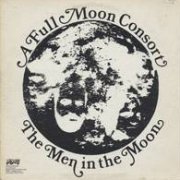 |
The Men in the Moon (1978, 39.34) ***/T½The Great WallThey Don't Know Where They're Going (Until They Get There) Walking the Streets at Night My Blue Roots Love Me Down I'm Telling You (It's All Been Said Before) Let's All Dream Together Ooo La La Come on Home |
Current availability:
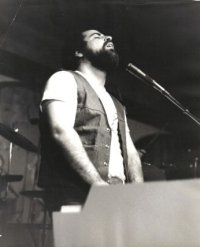 |
Mellotron used:
A Full Moon Consort were apparently one of the mid-'70s' biggest bands in the St. Louis area, although listening to their sole album, The Men in the Moon, with the benefit of a few decades' hindsight, it's difficult to understand why, to be honest. I've seen overgenerous comparisons to Steely Dan, as little of that band's wit, soulfulness and all-round talent is in evidence here and yes, I spotted the Do It Again cop on Walking The Streets At Night. This isn't to say this is actually a bad album, it's just all rather ordinary and suffers in comparison with other, better-known acts.
Joseph Marshall and Joe Truttman both add Mellotron to the proceedings, although it has to be said that if it wasn't credited, I'd be in two minds as to whether the album's string sounds actually had any tape-replay connection at all. We're talking typical 'string section replacement' stuff here (hang on; wasn't that the instrument's original purpose?), with light and occasional use on a mere three tracks, only the flutes near the end of closer Come On Home sounding at all Mellotronic, though clearly mixed with real strings. As you can see from the pic on the right, though, they certainly owned one, just didn't overuse it here. Incidentally, that's vocalist Chuck Sabatino playing it; Chuck went on to write songs for other artists, notably Head East and the Doobie Brothers' Michael McDonald (an early member of A Full Moon Consort), before dying prematurely in 1996.
So, The Men in the Moon isn't the most exciting album you'll ever hear, though fans of mid-'70s soft rock might feel their heart quicken, even if only for a moment. Not much Mellotron, either, despite two players, so don't go too far out of your way. Incidentally, there's a story that a St. Louis second-hand shop had so many copies of this a few years back, they were GIVING them away. Bizarre.
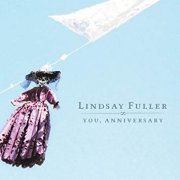 |
You, Anniversary (2012, 40.16) ***/TT |
|
| Everything I Ever Had Circa Never One More Song Grey Gardens You, Anniversary Sound of Regret Libby One Can Only Hope |
Martin Lake Coal Mine Canary |
|
Current availability:
Mellotron/Chamberlin used:
I've seen Lindsay Fuller's music described as Southern Gothic; think: dark Americana and you won't go too far off the mark. 2012's You, Anniversary is her third album, at its best on One More Song, the cranked-up title track and Martin Lake and closer Coal Mine Canary. Comparisons? Her intensity (and, occasionally, delivery) reminds me of Mike Scott, although this is a long way from The Waterboys' Celtic 'big music'.
Paul Bryan plays Mellotron and Chamberlin, chiefly the latter, by the sound of it, with what sounds like Chamby strings on Circa Never, One More Song, Grey Gardens and the title track and background Mellotron choirs on Libby. Country for people who don't like country.
See: Paul Bryan
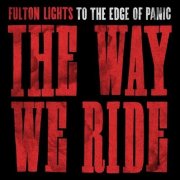 |
The Way We Ride (2008, 39.41) **½/½ |
|
| Fulton Lights to the Edge of Panic The Way We Ride Sideways Glances and Coded Speech The Sin Makes the Man Pen and Paper Blood and Guts We Hit First I Love Your Point of View |
Everybody's Running From Something Rest |
|
Current availability:
Mellotron used:
Fulton Lights are essentially Andrew Spencer Goldman plus collaborators, whose second album, 2008's The Way We Ride, was released as a highly limited-edition CD-R, although it seems to've escaped to a wider audience via the Internet. It fearlessly combines low-fi, indie, post-rock, the 'folk' of Neil Young and even country, noticeably on closer Rest's pedal steel, although how well the mixture works is pretty subjective.
Goldman plays Mellotron on Pen And Paper, with a ghostly string part that may or may not come from a real machine, although the vaguely tape-replay-like sounds on a couple of other tracks turn out to be synths. One for slowcore fans, I suspect, with a distinct Neil vibe on several tracks, although you really shouldn't bother for the Mellotron.
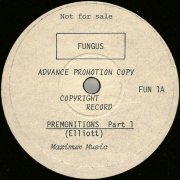 |
Premonitions (1973, 38.01) ***½/½Part 1Part 2 |
Current availability:
Mellotron used:
The startlingly-obscure Fungus were no more nor less than a pre-deal (and post-Second Hand/Chillum) Seventh Wave, their test pressing-only Premonitions being a dry run for the following year's Things to Come. Since doing a full A/B listen is the kind of thing that causes me to lose the will to live, even on a decent album, I'll let Mike (who told me about this in the first place) tell you that a couple of sections are missing and a couple more are extended, but, generally speaking, it's the same album.
Ken Elliott mostly plays synths, sounding as if he desperately wished he had a polyphonic machine or three, several years too early, with one small burst of Mellotron strings at the beginning of Part 2, presumably on what would become Premonition itself. This isn't different enough from the official release to make it worth the effort for all but the most committed (committed what I'm not going to say), but it's certainly an interesting curio for fans of obscure UK prog.
See: Seventh Wave
 |
2 (2012, 45.39) ***/½ |
|
| Heaven Shine Dirty Money Bushwhacker Chase the Dream Something Becomes the Other It Ain't Never Gonna Work Gettin' it Together Stop Think Work it Out |
Soul Survivor part 1 Do What You Do Take Down Persuasion After the Storm Darling Dear |
|
Current availability:
Mellotron used:
As you might have guessed from their name, the female-fronted Funkshone sport a brass section and are clearly dedicated to The Funk in all its aspects. Although they've released singles more recently, 2012's Funkshone 2 is their most recent long-player, a mix of soulful and funkier material, the latter sounding better to my ears. Highlights include instrumentals Dirty Money, the Blaxploitation-channelling Chase The Dream and Gettin' It Together, all sounding like they could've been TV themes from 1972, the '70s-esque sleeve art fitting the concept nicely.
My good friend Mark Wallis lent the band his M400 for the sessions, presumably played by Nino Auricchio, with (as far as I can make out) a brief string part on Stop Think Work It Out and possible vibes on After The Storm, although these could both be wrong and it could've been used elsewhere. Hard to tell. Funkshone are the kind of band who are clearly an absolute riot live, but I'm not sure how well their thing holds up on a rainy afternoon in February.
 |
Piece of Paradise (2006, 45.27) **/½ |
|
| One By One Wicked Smile Piece of Paradise Close to Fall Apart Soulless Streets Goodbye Sweet Sorrow Loose Ends Slightly Driftin' |
Underneath My Skin Maybe She Said |
|
Current availability:
Mellotron used:
2006's Piece of Paradise was Furia's second and last album, for which we should probably be grateful. Their shtick was 'transcendental indie', like a Norwegian (if English-language) Coldplay, making them something of a 'locals band'. As you might imagine, there are no better tracks.
Sylvia Massy (Shivy) plays (her own?) Mellotron on Maybe, with the faintest of faint choirs at the beginning of the track, barely audible at all. Absolute tosh, minimal Mellotron or no.
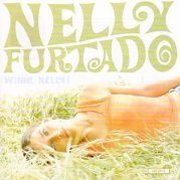 |
Whoa, Nelly! (2001, 49.14) **/T |
|
| Hey, Man! Shit on the Radio (Remember the Days) Baby Girl Legend I'm Like a Bird Turn Off the Light Trynna Finda Way Party |
Well, Well My Love Grows Deeper (part 1) I Will Make U Cry Scared of You |
|
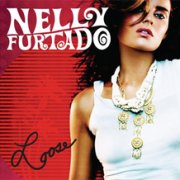 |
Loose (2006, 50.17) **½/T |
|
| Afraid Maneater Promiscuous Glow Showtime No Hay Igual Te Busque Say it Right |
Do it In God's Hands Wait for You All Good Things (Come to an End) |
|
 |
The Best of Nelly Furtado (2010, 70.35) **½/T |
|
| I'm Like a Bird Turn Off the Light Shit on the Radio (Remember the Days) Fotografia Powerless (Say What You Want) Try Força Promiscuous Maneater |
Say it Right All Good Things (Come to an End) In God's Hands Broken Strings Girlfriend in the City Night is Young Stars Manos al Aire |
|
Current availability:
Mellotron/Chamberlin used:
Canadian, but of Portuguese descent, Nelly Furtado's debut album, Whoa, Nelly!, has to be one of the most irritating records I've heard in several years. It's not just the programmed drums - that's only to be expected - but the infuriating production tricks with percussion and synth bleeps, combined with Ms. Furtado's whiny voice that make me want to reduce the thing to very small shards of broken plastic and high-grade aluminium foil. The 'songs' are rarely more than a piss-poor melody laid over one of these interchangeable backing tracks, although Nelly's lyrics occasionally seem to have some depth to them; Party doesn't actually appear to be about having a good time, being more about what such occasions can really be like. Although it's completely uncredited, in a CD booklet with what appears to be full instrumental credits, I'm assured that the Mellotron on major hit I'm Like A Bird is not only real, but is actually a new MkVI machine, which is pretty specific, with nice enough strings and cello parts, if (as so often) slightly inessential.
Her third album, Loose, carries on in a similar vein to her debut, albeit with more of her Portuguese heritage leaking through, probably at its least irritating on the (semi-) balladic Te Busque. Now, here things get confusing (again). I've clearly seen a reference at some point to Lester Mendez playing Chamberlin on the record, although it's now nowhere to be found. Mendez does play keys on Te Busque, with a flute run that could easily be a Chamby, which doesn't explain the tape-replayesque string line running through Glow, on which he doesn't play, the keys being covered by Floyd "Danja" Hills and Tim "Timbaland" Mosely. So, who knows? Is any of it real? Mendez does, however, get a definite Chamby credit on one of three previously-unreleased tracks on 2010's Best of... comp, with vague, background cellos on Stars, a track dating from the Loose sessions.
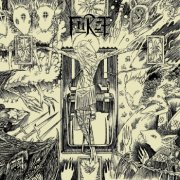 |
Psych Minus Space Control (2012, 43.02) ***/TTOccult Soul, With Mind...Psych Mooz Space Control Reaper Subconscious Guide Triad of Lucifer When Always Ready |
Current availability:
Mellotron used:
Furze are the one-man band of Kristian "Woe J. Reaper" Knapstad, who have released ten albums of (according to Discogs) 'experimental/psychedelic black metal', 2012's Psych Minus Space Control being the fifth. It's largely instrumental, relatively brief closer When Always Ready being the only track that conforms to what you might expect of a black metal album. Is there a 'best track'? Maybe the fourteen-minute Psych Mooz Space Control, but you really have to be into deathly slow, sludgy riffology to get anything much out of this.
Knapstad plays one (or more) of Lars Fredrik Frøislie's M400s, with a skronky flute line on opener Occult Soul, With Mind..., a minute of solo cello kicking off Reaper Subconscious Guide, with more of the same later on and reedy choirs at the beginning of Triad Of Lucifer. Knapstad vocalises on the last-named, too, quite distinct from the Mellotron. Do you need to hear this? It's down to taste, I suppose, although that solo cello section's worth it for the Mellotron fan.
 |
Fuse (1970, 38.08) ****/T½Across the SkiesPermanent Resident Show Me To Your Health In a Window 4/4 3/4 Mystery Ship Sad Day |
Current availability:
Mellotron used:
The otherwise utterly obscure Fuse are known solely these days for being the first recording band of Rick Nielsen and Tom Peters(s)on, later of the mighty Cheap Trick. Their lone, self-titled album is actually a monster psychedelic heavy blues record with some killer playing and excellent songs, which will almost certainly colonise my CD player if I give it half a chance. Despite a couple of weaker spots, it's deserving of being far better-known than it is.
Rick plays both guitar and keyboards (at which he's actually very good), with plenty of decent Hammond work. The story goes, Rick's dad owned a music shop and imported one of the first (MkII, of course) Mellotrons into the States, which Rick lost no time in borrowing. There are several points on the album which might be Mellotron, but given the complete over-the-topness of the string work on To Your Health, I doubt if any of the suspected parts actually are at all. I mean, have you ever heard a Mellotron almost distort before? Apart from on the second Gracious! album, that is...
See: Cheap Trick | Mellodrama
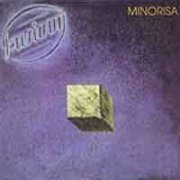 |
Minorisa (1975, 37.53) ****/TTTTEbusasMinorisa Llaves del Subconsciente Part I: Mente Part II: Cerebro |
Current availability:
Mellotron used:
Minorisa was Fusioon's third album and probably their most eclectic; every online review I've read comments on its schizophrenic nature, lurching from one style to another with abandon. The album is held together by its inherent jazziness, which isn't to say it's a fusion (ho ho) album; definitely 'prog', whatever you take that to mean. The joker in the pack is the two-part Llaves Del Subconsciente, more about synth exploration than the offbeat prog of the rest of the album, especially part two. It's not a bad track, just a little out of place; maybe they were short of material.
On the Mellotron front, played by Manuel Camp, Ebusas is loaded with strings, choirs and flutes, including brief choir and flute solo parts in the middle. He takes a similar approach in the title track, along with what sounds to my ears like Mellotron FX church bells, though I'm willing to be proven wrong. Llaves Del Subconsciente has an upfront string part in part one, but part two is entirely composed of analogue sequencer blips and drones, rather precluding anything more organic.
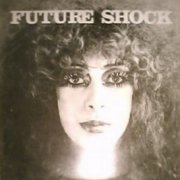 |
Future Shock (1977, 42.53) ***/TT½ |
|
| The Ouverture Tides Are Turning Boogie Love Theme Cup-a-Love Rent-a-Family Spanish Dream Where We Came in |
Forever and a Day Love Theme Well, Well Stand Back Temporary True Believer Fruity We're Together |
|
Current availability:
Mellotron used:
As far as I can work out, Future Shock was a touring stageshow, utilising Cirkus (of One fame) as the production's band, the songs being released under the show's name. Future Shock is a most peculiar album, to be honest; it lulls the listener into a false sense of security, beginning in a far more symphonic vein than the Cirkus album, before Tides Are Turning ends with the sound of the needle being dragged across the groove, while a voice remarks 'They can't write music like they used to in the sixties' and the band break into a by-numbers boogie, er, Boogie. There are other spoken-word interludes, some sillier than others and a general overall feel of writers (none actually in the band, for what it's worth) who had ingested far too much Monty Python and bad drugs, feeling duty-bound (sadly) to foist their sense of humour on the public at large (see: their Roxy Music pastiche on Fruity).
As for the Mellotron (presumably played by Cirkus' Derek G. Miller), Tides Are Turning has a single-note string line that merges into a guitar lead, with discordant choir later in the song. Love Theme only has a few seconds of strings at the beginning and Where We Came In has some quiet string chords dotted throughout the song, with more of the same on Forever And A Day. Love Theme features a distinctive strings part behind a more serious spoken-word piece about life and love an' all that, while a few choir chords on Temporary True Believer round up the album's Mellotron content.
See: Cirkus
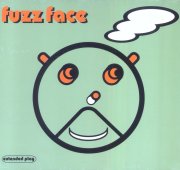 |
Fuzz Face EP (1996, 15.28) ***½/TTTMr DoomsdayThe Great and Unknown Prosperity is Like the Tide For Tomorrow |
Current availability:
Mellotron used:
Fuzz Face (named for the distortion pedal, of course: see the sleeve reference) seem to've been a one-off project from Midnight Oil guitar/keys man Jim Moginie and a couple of mates, Moginie doing the lion's share of the playing. Fuzz Face is all too brief; four tracks of good, aggressive guitar-driven stuff, very little like his alma mater, but also destined to sell diddly-squat to Oils fans.
Moginie also played Mellotron on the Oilers' 1993 release, Earth and Sun and Moon, although there's no specific credit on the sleeve. Whether he's ever actually owned one is unknown, but assuming it's genuine, there are flutes here in between the loud bits on Mr Doomsday, with more of the same on all the other tracks and strings on For Tomorrow. Some of the playing is pretty unusual, too, notably on Prosperity Is Like The Tide, bumping the album's 'T' rating up a notch. Well, I found this in a Melbourne second-hand shop for a whole Aussie dollar and consider it money well spent. If slightly off-kilter songs with a heavy Mellotron presence sounds like your thing, you could do a lot worse than to pick this up.
See: Jim Moginie | Midnight Oil
 |
Bound for Space (1987, 41.14) *½/TBound for Space (Ouvertyre)Sunrise There Should Be No War Please Forgive Me Step By Step Hymn to Universe Facing the Sky Thunder and Rain Lullaby |
Current availability:
Mellotron used:
For as long as I've known of his existence, I've been under the impression that Egil Fylling's work would fall under the rather broad 'new age' umbrella; you know, drifting, meditative synths, little actual melody, pleasant, if unremarkable. Well, I can't tell you anything about his later work, but going by his second album, 1987's Bound for Space, his early phase sounds like an unholy cross between the Windham Hill label's output, the Emerson, Lake & Powell album and the worst end of The Enid's '80s recordings. Opener Bound For Space (Ouvertyre) is a hideous blend of early digital synths and programmed drums, There Should Be No War is a terrible vocal number (he can not sing), Please Forgive Me's a sappy, sax-led, instrumental ballad... Are you getting the idea?
Fylling plays Mellotron, if only just, with heavily-reverbed, choral choirs on the album's longest track, the nine-minute Thunder And Rain, to no great effect. This album is a monument to the crass tastelessness of so much '80s music. Everything about it stinks, from the insipid composition through the keyboard and drums sounds, the terrible slap bass and MOR sax to the awful (if, thankfully, limited) vocals. I was actually hoping for a decent listen and have been denied it on an industrial scale. Thankfully, this is generally unavailable. Long may that situation last.
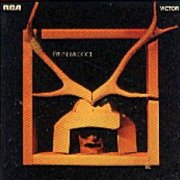 |
Fynn McCool (1970, 40.50) ***/T |
|
| U.S. Thumb-Style Hoeless Prescription Hey Ho! Diamond Lil Great Change Coming on The Road to Wisdom The Only Way to Feel Faith of Clay |
Shattered Part 1 Part 2 |
|
Current availability:
Mellotron used:
Until recently, information about Fynn McCool's sole 1970 album has been incredibly hard to find, with the only source for ages being a Polish site that listed various song titles, some more accurate than others. Thankfully, the situation has changed, with enough 'Net info now available for me to be able to tell you that the band metamorphosed out of a Rhodesian outfit called The Shake Spears (ho ho), who moved first to Belgium (!), then the UK via Australia. Confused yet? They became McCool in 1968, releasing their sole, eponymous album in 1970.
Like so many one-shot progressives from the era, Fynn McCool contains something of a mish-mash of styles, the organ-led proto-prog of The Only Way To Feel, Faith Of Clay or the lengthy two-part Shattered contrasting sharply with the boogie of U.S. Thumb-Style, the singalong Hey Ho! or the country/folk of Diamond Lil. The Road To Wisdom is the sole Mellotron track (played by Mick Fowler), described on the aforementioned Polish site as, "choć ozdobiony brzmieniem melotronu", which apparently translates directly as 'although patterned tone Mellotron'. Which is useful. It actually features a rather perfunctory string part in an ordinary, slightly countryish song, although it might've worked better on a couple of their proggier efforts.